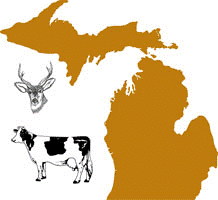Wildlife Disease and Zoonotics
Date of this Version
12-19-2008
Abstract
Bovine tuberculosis, caused by infection with Mycobacterium bovis, is a re-emerging zoonotic disease. It has staged a comeback by establishing infections in wildlife and cattle, creating the potential for human disease in locations where it was thought to be under control. In northwestern Minnesota, infected cattle and white-tailed deer were first discovered in 2005. A major bovine tuberculosis eradication campaign is underway in the state, with multiple efforts employed to control M. bovis infection in both cattle and deer populations. In order to effectively eradicate bovine tuberculosis in Minnesota, there is a need for better understanding of the factors that increase the risk of deer and cattle interacting in a way that facilitates tuberculosis transmission. By reducing the risk of disease transmission within the animal populations, we will also reduce the risk that bovine tuberculosis will again become a common disease in human populations.
The purpose of this study is to characterize the risk of interactions between cattle and white-tailed deer in northern Minnesota in order to prevent M. bovis transmission. A survey originally developed to assess deer-cattle interactions in Michigan was modified for use in Minnesota, introducing a scoring method to evaluate the areas of highest priority at risk of potential deer-cattle interaction. The resulting semi-quantitative deer-cattle interaction risk assessment was used at 53 cattle herds located in the region adjacent to the bovine tuberculosis “Core Area”. Two evaluators each scored the farm separately, and then created a management plan for the farm that prioritized the areas of greatest risk for deer-cattle interactions. Herds located within the “Management Zone” were evaluated by Minnesota Board of Animal Health staff, and results from these surveys were used as a point of comparison.


Comments
In partial fulfillment of the requirements for Master’s Degree in Public Health, Executive Program at the School of Public Health, University of Minnesota.